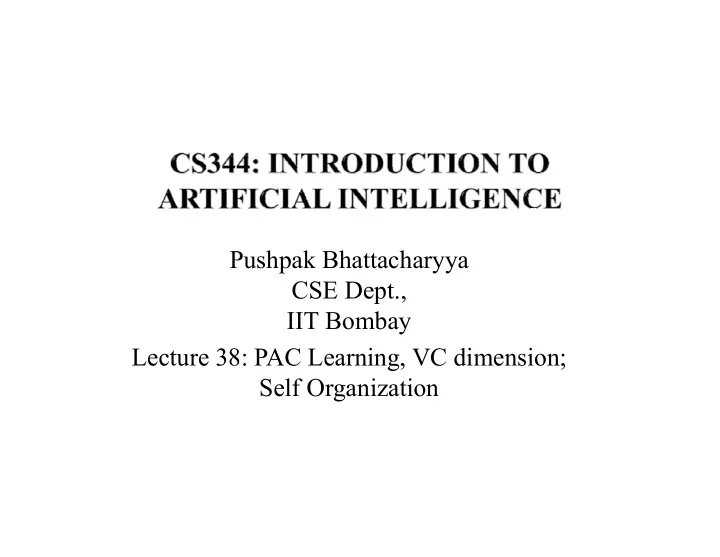

Pushpak Bhattacharyya CSE Dept., IIT B IIT Bombay b Lecture 38: PAC Learning, VC dimension; S lf O Self Organization i ti
VC dimension VC-dimension Gives a necessary and sufficient condition for Gives a necessary and sufficient condition for PAC learnability.
Def:- Def: Let C be a concept class, i.e., it has members c1,c2,c3,…… as concepts in it. , , , p C C1 C3 C3 C2
Let S be a subset of U (universe). Let S be a subset of U (universe). Now if all the subsets of S can be Now if all the subsets of S can be produced by intersecting with C i s , then we say C shatters S.
The highest cardinality set S that can be The highest cardinality set S that can be shattered gives the VC-dimension of C. VC-dim(C)= |S| VC-dim: Vapnik-Cherronenkis dimension.
y 2 – Dim surface C = { half planes} x IIT Bombay 6
y S 1 = { a } { } 1 a {a}, Ø x |s| = 1 can be shattered IIT Bombay 7
y S 2 = { a,b } b b {a,b}, a {a} {a}, {b}, Ø x |s| = 2 can be shattered IIT Bombay 8
y S 3 = { b b a,b,c } a c x |s| = 3 can be shattered IIT Bombay 9
IIT Bombay 10
y S 4 = { a,b,c,d } A B C C D D x |s| = 4 cannot be shattered IIT Bombay 11
� A Concept Class C is learnable for all � A Concept Class C is learnable for all probability distributions and all concepts in C if and only if the VC dimension of C is finite � If the VC dimension of C is d , then…(next page) IIT Bombay 12
(a) for 0< ε <1 and the sample size at least ( ) p max[(4/ ε )log(2/ δ ), (8d/ ε )log(13/ ε )] any consistent function A:S c � C is a learning function for C (b) for 0< ε <1/2 and sample size less than max[((1- ε )/ ε )ln(1/ δ ), d(1-2( ε (1- δ )+ δ ))] No function A:S c � H, for any hypothesis space is a learning function for C. l f f IIT Bombay 13
Book Computational Learning Theory, M. H. G. 1. Anthony, N. Biggs, Cambridge Tracts in Theoretical Computer Science, 1997. h l C S 1997 Paper’s 1 A theory of the learnable Valiant LG (1984) 1. A theory of the learnable, Valiant, LG (1984), Communications of the ACM 27(11):1134 -1142. 2. Learnability and the VC-dimension, A Blumer, A Ehrenfeucht, D Haussler, M Warmuth - Journal of the ACM, 1989. f th ACM 1989
Biological Motivation Biological Motivation Brain
Higher brain Brain Cerebellum Cerebellum Cerebrum Cerebrum 3 Layers: Cerebrum 3- Layers: Cerebrum Cerebellum Higher brain
Search Search Contributing to humanity for Meaning Achievement,recognition Food,rest survival
Higher brain ( responsible for higher needs) 3 L 3- Layers: Cerebrum C Cerebrum b C b (crucial for survival) Cerebellum Higher brain
Back of brain( vision) Lot of resilience: Lot of resilience: Visual and auditory areas can do each other’s job th ’ j b Side areas For auditory information processing For auditory information processing
Left Brain and Right Brain Left Brain and Right Brain Dichotomy Left Brain Right Brain
Left Brain – Logic, Reasoning, Verbal ability Right Brain Emotion Creativity Right Brain – Emotion, Creativity Words Words – left Brain left Brain M Music i Tune – Right Brain g Maps in the brain. Limbs are mapped to brain
Character Reognition , O/p grid O/p grid . . . . . . . . I/p neuron I/p neuron
• Self Organization or Kohonen network fires a Self Organization or Kohonen network fires a group of neurons instead of a single one. • The group “some how” produces a “picture” of The group some how produces a picture of the cluster. • Fundamentally SOM is competitive learning. • But weight changes are incorporated on a neighborhood. • Find the winner neuron, apply weight change for Fi d h i l i h h f the winner and its “neighbors”.
Wi Winner Neurons on the contour are the “neighborhood” neurons.
Weight change rule for SOM Weight change rule for SOM W (n+1) = W (n) + η (n) ( I (n) – W (n) ) W ( +1) W ( ) + ( ) ( I ( ) W ( ) ) P+ δ (n) P+ δ (n) P+ δ (n) Neighborhood: function of n Learning rate: function of n δ (n) is a decreasing function of n δ ( ) i d i f ti f η (n) learning rate is also a decreasing function of n 0 < η (n) < η (n –1 ) <=1
Pictorially Winner δ (n) δ (n) Convergence for kohonen not proved except for uni- dimension . . . .
A … P neurons o/p layer W p … … . n neurons Clusters: A : A A : A : B : : C : C :
Recommend
More recommend